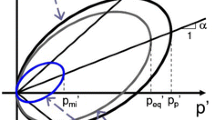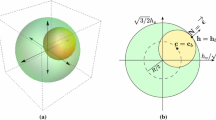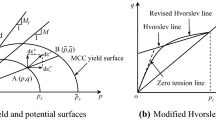Abstract
The stress–strain response of stiff plastic clays is known to be highly non-linear and anisotropic. However, whilst there have been many investigations on the non-linearity of stiff plastic clays, this is not the case for stiffness anisotropy. It is generally believed that, at least at small strains, soil stiffness is anisotropic and can be interpreted within the framework of cross-anisotropic elasticity. However, very few measurements of all cross-anisotropic stiffness parameters have been reported in the literature. Recent research on stiff plastic London Clay, from London’s Heathrow Airport Terminal 5 (T5), is one of the few examples where these independent stiffness parameters have been quantified. On the basis of these research findings, this paper uses a cross-anisotropic non-linear elasto-plastic model to simulate the behaviour of London Clay. The model is used to simulate a number of laboratory tests and the predictions are compared with available experimental data from the T5 investigation. The predictions of the cross-anisotropic non-linear elasto-plastic model for the laboratory tests are also compared with those of an isotropic model, which has been used successfully in the past to simulate the behaviour of stiff plastic clays. Predictions obtained with the two models are then compared in the numerical analyses of a tunnel constructed within the London Clay. Both short-term undrained and long-term drained conditions are examined in fully coupled analyses.









Similar content being viewed by others
References
Addenbrooke TI, Potts DM, Puzrin AM (1997) The influence of pre-failure soil stiffness on numerical analysis of tunnel construction. Geotechnique 47(3):693–712
Al-Tabbaa A and Wood DM (1989) An experimental based “bubble” model for clay. International conference on numerical models in Geomechanics, eds. Pietruszczak A and Pande GN, 91–99
Anagnostopoulos A et al (eds) (2011) Proceedings of the 15th European conference on soil mechanics and geotechnical engineering. IOS Press, Amsterdam
Dafalias YF and Herrmann LR (1980) A bounding surface soil plasticity model. International Symposium on Soils under Cyclic and Transient loading, Swansea, 1:335–345
Franzius JN (2004) The behaviour of buildings due to tunnel induced subsidence. Ph.D Thesis, Imperial College, University of London
Franzius JN, Potts DM, Burland JB (2005) The influence of soil anisotropy and Ko on ground surface movements resulting from tunnel excavation. Geotechnique 55(3):189–199
Gasparre A (2005) Advanced laboratory characterisation of London Clay. PhD Thesis, Imperial College, University of London
Gasparre A, Nishimura S, Minh NA, Coop MR, Jardine RJ (2007) The stiffness of natural London Clay. Geotechnique 57(1):33–47
Graham J, Houlsby GT (1983) Anisotropic elasticity of a natural clay. Geotechnique 33(2):165–180
Grammatikopoulou A, Zdravkovic L, Potts DM (2006) General formulation of two kinematic hardening constitutive models with a smooth elasto-plastic transition. Int J Geomech ASCE 6(5):291–310
Hight DW and Higgins KG (1995) An approach to the prediction of ground movements in engineering practice: background and application. Proc. of the Intern. Symposium on Pre-failure Deformation of Geomaterials, Sapporo, 909–945
Hight DW, Gasparre A, Nishimura S, Minh NA, Jardine RJ, Coop MR (2007) Characteristics of the London clay from the terminal 5 site at Heathrow Airport. Geotechnique 57(1):3–18
Jardine RJ, Symes MJ, Burland JB (1984) The measurement of soil stiffness in the triaxial apparatus. Geotechnique 50(3):323–340
Jardine RJ, Potts DM, Fourie AB, Burland JB (1986) Studies of the influence of non-linear stress-strain characteristics in soil-structure interaction. Geotechnique 36(3):377–396
Jardine RJ, Potts DM, St John HD, Hight DW (1991) Some practical applications of a non-linear ground model. Proceedings of the 10th European Conference on Soil Mechanics and Foundation Engineering, Florence, 1:377–396
Lings ML, Pennington DS, Nash DF (2000) Anisotropic stiffness parameters and their measurement in a stiff natural clay. Geotechnique 50(2):109–125
Mair RJ (2008) Tunnelling and geotechnics: new horizons. Geotechnique 58(9):695–736
Mair RJ and Taylor RN (1997) Bored tunnelling in the urban environment, State-of-the-art Report and Theme Lecture. Proceedings of 14th International Conference on Soil Mechanics and Foundation Engineering, Hamburg, 4:2353–2385
Minh NA (2006) An investigation of the anisotropic stress-strain-strength characteristics of an Eocene Clay. PhD Thesis, Imperial College, University of London
Mroz Z, Norris VA, Zienkiewicz OC (1978) An anisotropic hardening model for soils and its application to cyclic loading. Int J Numer Anal Methods Geomech 2:203–221
Nyren RJ, Standing JR and Burland JB (2001) Surface displacements at St James’s Park greenfield reference site above twin tunnels through the London Clay. In: Building response to tunnelling: Case studies from construction of the Jubilee Line Extension, London eds. Burland JB, Standing JR and Jardine FM 2:387–400
Potts DM, Zdravkovic L (1999) Finite element analysis in geotechnical engineering: theory. Thomas Telford, London
Potts DM, Zdravkovic L (2001) Finite element analysis in geotechnical engineering: application. Thomas Telford, London
St John HD, Potts DM, Jardine RJ, Higgins KG (1993) Prediction and performance of ground response due to construction of a deep basement at 60 Victoria Embankment. Predictive Soil Mechanics—Proceedings of the Wroth Memorial Symposium, Oxford, Thomas Telford, London, 581–607
Whittle AJ (1993) Evaluation of a constitutive model for overconsolidated clays. Geotechnique 43(2):289–313
Author information
Authors and Affiliations
Corresponding author
Additional information
*Previously published in Anagnostopoulos et al. (2011). Reprinted—Published in revised form with kind permission of IOS Press.
Appendices
Appendix 1
1.1 Isotropic Non-Linear Elasto-Plastic Model
The equations describing the variation of the tangent shear modulus, G, and tangent bulk modulus, K, in the non-linear range are as follows:
where
In the above equations A, B, C, R, S, T, β, γ, δ and μ are material constants, p′ is the mean effective stress, ε v is the volumetric strain and E d is the deviatoric strain, defined as follows:
The above equations are derived from differentiation of the secant equations given in the original publication (Jardine et al. 1991). Owing to the trigonometric nature of Eqs. 2 and 3, minimum (E dmin , ε vmin ) and maximum (E dmax , ε vmax ) strain limits are set, below and above which the tangent shear and bulk moduli vary only with mean effective stress. Furthermore, the magnitude of the stiffness is prevented from falling below specified minimum values, G min and K min .
The non-linear elastic model is combined with a Mohr–Coulomb yield surface and a non-associated flow rule.
1.2 Anisotropic Non-Linear Elasto-Plastic Model
This model (Franzius 2004; Franzius et al. 2005) combines the transversely anisotropic formulation of Graham and Houslby (1983) with a non-linear response based on the isotropic non-linear model described previously. This appendix gives the basic equations of the model. The tangent vertical Young’s modulus \( E_{v}^{\prime } \) is defined as:
where
In the above equations A, B, C, β and γ are constants, p′ is the mean effective stress and E d is the deviatoric strain which has been defined in Eq. 7. Owing to the trigonometric nature of Eq. 8 minimum (E dmin ) and maximum (E dmax ) strain limits are set, below and above which the tangent vertical Young’s modulus varies only with mean effective stress. Moreover, the magnitude of the stiffness is prevented from falling below a specified minimum value \( E_{v}^{\prime } \) min . The model has two additional parameters: the drained Poisson’s ratio v′ hh and the anisotropic scale factor α defined in Eq. 1.
Similar to the isotropic non-linear model, this anisotropic non-linear formulation is combined with a Mohr–Coulomb yield surface and a non-associated flow rule.
Appendix 2
Gasparre (2005) and Gasparre et al. (2007) describe in detail how the five independent stiffness parameters of a cross anisotropic soil can be calculated by combining BE measurements and static TX. This Appendix gives the equations referred to in Fig. 2. These are as follows:
For an explanation on how these equations are derived the reader is referred to the original publications, i.e., Gasparre (2005) and Gasparre et al. (2007).
Rights and permissions
About this article
Cite this article
Grammatikopoulou, A., Schroeder, F.C., Gasparre, A. et al. The Influence of Stiffness Anisotropy on the Behaviour of a Stiff Natural Clay. Geotech Geol Eng 32, 1377–1387 (2014). https://doi.org/10.1007/s10706-013-9655-1
Received:
Accepted:
Published:
Issue Date:
DOI: https://doi.org/10.1007/s10706-013-9655-1




